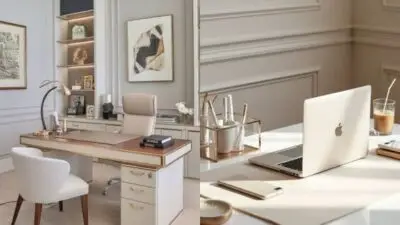Art Deco interior design emerged in the 1920s and 1930s as a celebration of luxury, glamor, and modernism. With its distinctive geometric patterns, bold jewel tones, and rich materials, Art Deco brought an unprecedented level of sophistication to interior spaces. This timeless aesthetic combines sleek lines with intricate motifs to create environments that feel both opulent and meticulously crafted, making it one of the most enduring design movements of the 20th century.
When you incorporate Art Deco elements into your home, you’re embracing more than just a style—you’re invoking the spirit of an era defined by innovation and exuberance. The style’s signature elements include stylized curves, atmospheric lighting, and sumptuous materials like lacquer, chrome, and exotic woods. These components work together to create spaces that feel both decadent and precisely balanced, offering a visual richness that few other design movements can match.
Key Takeaways
- Art Deco interior design blends geometric patterns with luxurious materials to create spaces that feel both sophisticated and dramatically opulent.
- You can incorporate Art Deco elements through bold color choices, symmetrical arrangements, and statement lighting fixtures with distinctive angular forms.
- Modern interpretations of Art Deco style allow you to balance historical glamor with contemporary functionality for a timeless yet livable aesthetic.


History and Influence of Art Deco
Art Deco emerged in the early 20th century as a revolutionary design movement that transformed interior aesthetics. This distinctive style evolved from various influences including Art Nouveau, Cubism, and the Bauhaus school, creating a unique visual language that celebrated modernity and luxury.
1920s and the Great Gatsby
The 1920s saw Art Deco reach its first peak of popularity, perfectly capturing the era’s spirit of exuberance and prosperity. This period, immortalized in F. Scott Fitzgerald’s “The Great Gatsby,” embraced the bold geometric patterns and luxurious materials that defined Art Deco interiors.
In your home, you might have recognized Art Deco elements through:
- Bold geometric shapes and symmetrical patterns
- Rich materials like exotic woods, marble, and mirrored surfaces
- Metallic accents in chrome, brass, and gold
The economic boom following World War I fueled demand for these luxury items. Wealthy homeowners showcased their prosperity through Art Deco furnishings that combined handcrafted quality with modern manufacturing techniques.
Exposition Internationale des Arts Décoratifs et Industriels Modernes
The 1925 Exposition Internationale des Arts Décoratifs et Industriels Modernes in Paris formally introduced Art Deco to the world. This landmark exhibition gave the movement its name and established its defining characteristics.
When you explore Art Deco’s foundations, you’ll discover how this exposition showcased:
- Innovative furniture designs from prominent creators
- Architectural models featuring streamlined forms
- Decorative objects that blended functionality with artistic expression
The exhibition attracted visitors from across the globe, spreading Art Deco’s influence internationally. American designers returned home inspired, adapting the style to create uniquely American interpretations that would shape skylines and interiors throughout the 1930s.
French designers emphasized craftsmanship and luxury, while American interpretations often embraced mass production techniques that made the style more accessible to middle-class consumers.

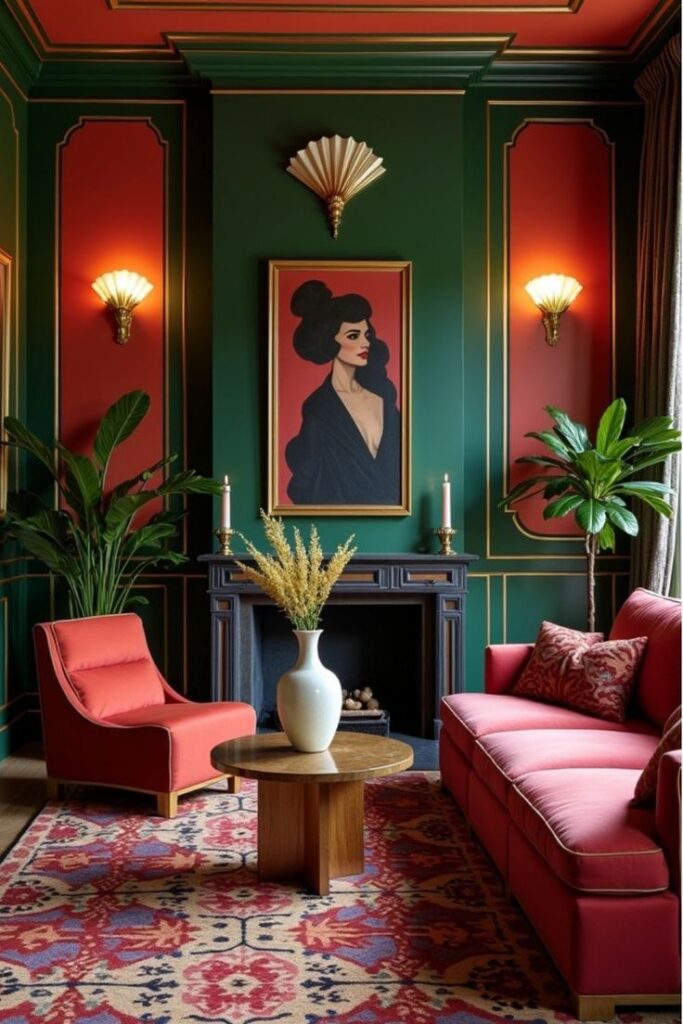
Key Elements of Art Deco Style
Art Deco’s distinctive aesthetic relies on bold visual elements that create a sense of luxury and modernity. The style combines geometric precision with opulent materials and metallic accents to achieve its signature look.
Geometric Shapes and Patterns
Art Deco embraces clean, streamlined shapes and strong geometric patterns. You’ll find zigzags, chevrons, and stepped forms that create visual rhythm throughout interiors. These patterns often appear on walls, floors, and furniture, establishing a sense of order and sophistication.
Bold angular forms replace the flowing curves of earlier styles. Look for sunburst motifs, stylized flowers, and symmetrical designs that demonstrate the mathematical precision characteristic of Art Deco.
Wall treatments frequently incorporate geometric wallpapers or painted patterns. Floors might feature checkerboard tiles or intricate inlaid designs that draw the eye and define spaces.
Luxury Materials and Textures
The Art Deco style elevates interiors through sumptuous materials that exude opulence. You’ll encounter exotic woods like ebony and zebrawood with high-gloss finishes that reflect light dramatically.
Lacquered wood surfaces in deep, rich colors add depth and sophistication to furniture pieces. These glossy finishes require meticulous craftsmanship to achieve their mirror-like appearance.
Other signature materials include:
- Marble and onyx for tabletops and floor inlays
- Shagreen (sharkskin) for decorative surfaces
- Animal hides like zebra and tiger (now typically faux)
- Glass, especially etched and frosted varieties
- Mirrors used liberally to amplify light and space
Metallic Finishes and Accents
Metallic elements define the glamorous essence of Art Deco design. You’ll find chrome details on furniture, lighting fixtures, and decorative objects that provide sleek, reflective surfaces.
Gold and gold leaf applications signal luxury and sophistication. These precious finishes appear on furniture trim, lighting fixtures, and architectural elements like ceiling medallions or door hardware.
Bronze and copper develop rich patinas that add warmth to the otherwise cool palette. These metals often appear as sculptural elements, lamp bases, or decorative panels.
Polished metal surfaces create dramatic light effects, especially when combined with mirrors. Lighting fixtures feature metallic detailing with geometric shades that cast interesting patterns when illuminated.
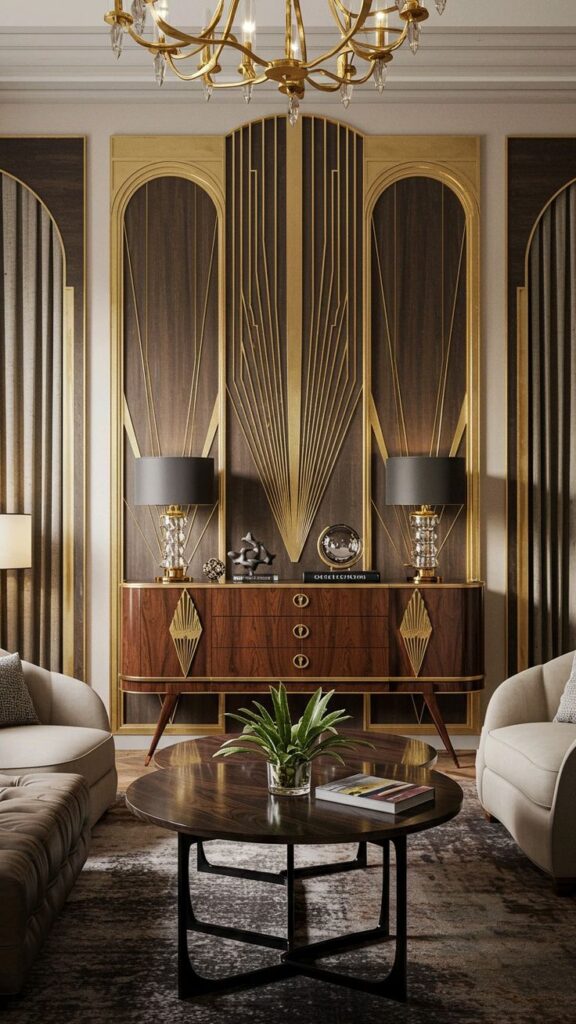
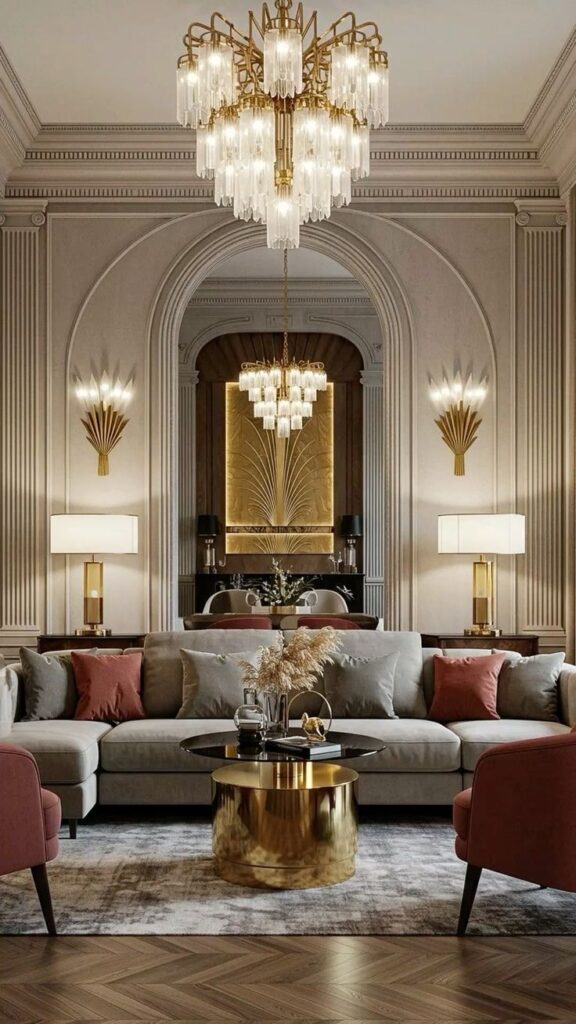
Iconic Art Deco Architecture
Art Deco architecture represents the glamour and technological progress of the early 20th century through distinctive geometric patterns and luxurious materials. These buildings feature symmetrical designs, stepped profiles, and decorative elements that exemplify the movement’s elegance and modernity.
Empire State Building
The Empire State Building stands as a quintessential Art Deco masterpiece in New York City’s skyline. Completed in 1931, its striking stepped design creates a distinctive silhouette recognized worldwide. The building rises 102 stories with a symmetrical tower that narrows as it ascends, embodying the classic Art Deco setback style.
Inside, you’ll find remarkable Art Deco details throughout the lobby, including marble walls, decorative metal work, and geometric patterns that exemplify the style’s luxurious aesthetic. The ceiling features stunning inlaid designs with gold and aluminum trim.
The exterior showcases vertical lines that emphasize height and verticality, a hallmark of Art Deco architecture. This emphasis on upward movement creates a sense of aspiration and progress, themes central to the Art Deco movement.
Chrysler Building
The Chrysler Building, completed in 1930, represents perhaps the most celebrated Art Deco skyscraper in the world. Its iconic stainless-steel crown features a series of arches and triangular windows that create a sunburst pattern, making it instantly recognizable in the Manhattan skyline.
You’ll notice automotive-inspired details throughout the building, reflecting the Chrysler automobile company’s ownership. The facade incorporates stylized eagle gargoyles and radiator cap ornaments that blend technological progress with artistic expression.
The lobby continues the automotive theme with exotic marbles, wood inlays, and a dramatic ceiling mural depicting industrial scenes. The elevator doors feature intricate geometric patterns in metal and wood, showcasing the meticulous craftsmanship typical of Art Deco.
The building’s triangular windows, as mentioned in the ELLE Decor reference, create dramatic light patterns inside while contributing to the structure’s distinctive exterior appearance.


Designing Art Deco Interiors
Creating an Art Deco interior requires attention to bold geometric patterns, rich materials, and statement pieces that capture the glamour of the 1920s and 1930s. The right furniture, accessories, and color schemes will help you achieve this timeless aesthetic that balances luxury with functionality.
Choosing Art Deco Furniture
Art Deco furniture features clean lines, geometric shapes, and luxurious materials. Look for pieces with high-gloss finishes, exotic woods like ebony or zebrawood, and sleek silhouettes.
Typical furniture includes club chairs with curved backs, low-profile sofas, and streamlined cabinets with symmetrical designs. Chrome, glass, and mirrored surfaces are signature elements that add the characteristic Art Deco shine.
When selecting furniture, prioritize pieces with stepped or sunburst designs, which were iconic motifs of the era. Built-in furniture and custom cabinets with geometric hardware can establish the period aesthetic while remaining functional.
Consider these key furniture elements:
- Materials: Lacquered wood, chrome, glass
- Shapes: Curved forms, symmetrical designs
- Details: Inlaid patterns, contrasting veneers
Incorporating Statement Pieces
Statement pieces define Art Deco interiors and serve as focal points in your space. A bold chandelier with geometric glass panels or chrome details can transform a dining area instantly.
Large mirrors with sunburst frames or stepped designs are quintessential Art Deco elements. Place them strategically to enhance light and create drama in your space.
Look for accessories with bold patterns such as zigzags, chevrons, and stylized natural motifs. Sculptures featuring sleek animals or stylized human forms in materials like bronze, ivory, or chrome add authentic period charm.
Decorative screens with geometric patterns can divide spaces while maintaining the aesthetic. Consider these bold additions:
- Geometric patterned rugs in contrasting colors
- Chrome and glass bar carts
- Bold abstract art in symmetrical frames
- Sculptural table lamps with geometric bases

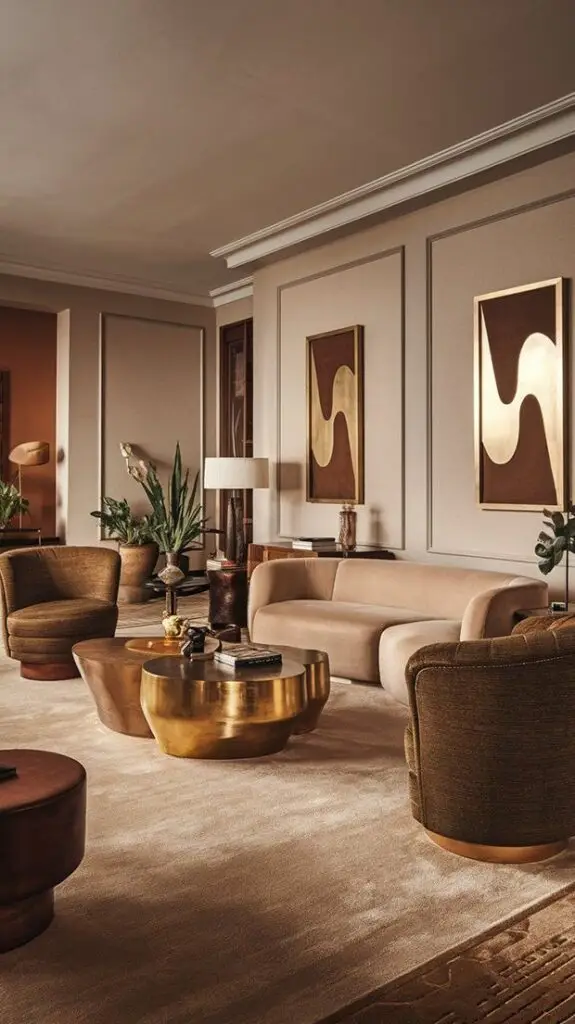
Art Deco Bathroom Ideas
The bathroom offers excellent opportunities to embrace Art Deco luxury through fixtures and finishes. Black and white tile patterns, particularly in checkerboard or geometric layouts, create an authentic foundation.
Install a pedestal sink with chrome legs or a vanity with high-gloss lacquer finish. Choose cabinet hardware with streamlined shapes and chrome or brass finishes to maintain period consistency.
Wall-mounted sconces with frosted glass shades flanking a geometric mirror create the perfect Art Deco lighting scheme. Consider adding built-in shelving with decorative trim to display perfume bottles and luxury toiletries.
Key bathroom elements:
- Chrome fixtures with angular designs
- Geometric tile patterns in contrasting colors
- Vanity mirrors with stepped frames or backlit edges
- Glass shower doors with decorative metalwork
For color schemes, embrace bold jewel tones like emerald green or sapphire blue paired with metallic accents. Alternatively, a monochromatic palette of black, white, and silver creates a classic Art Deco bathroom that feels both period-appropriate and timeless.
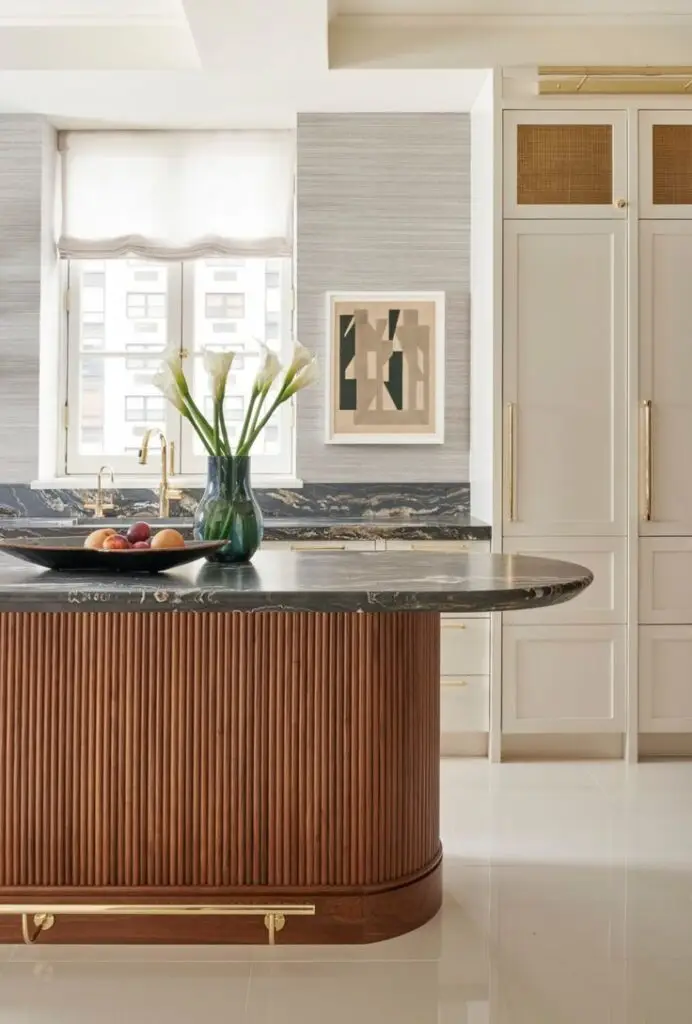
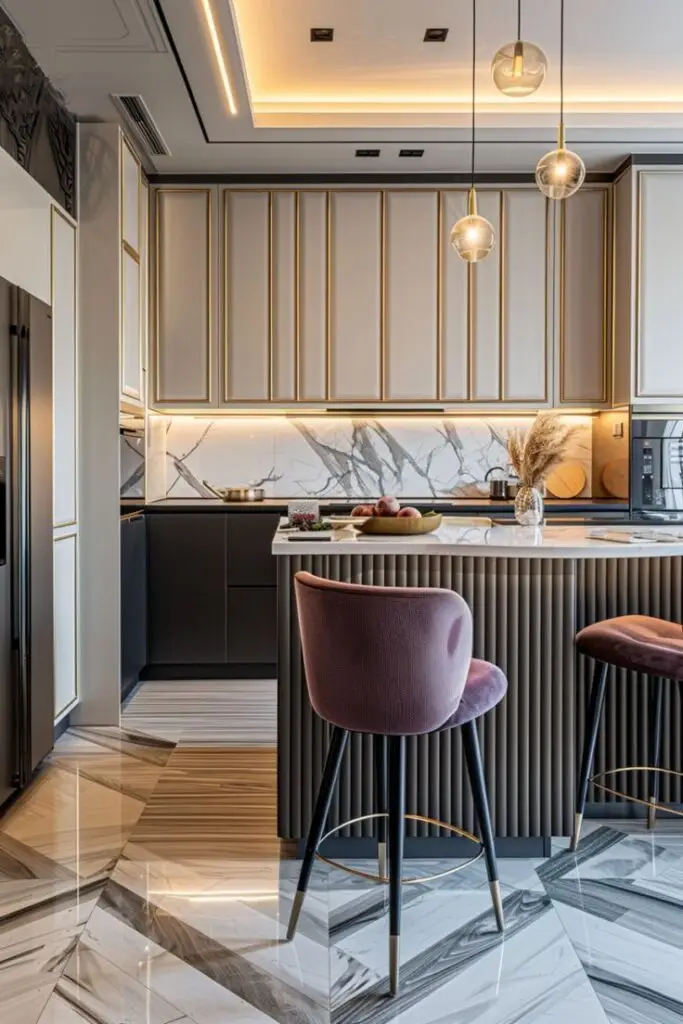
Modern Interpretations and Trends
Art Deco has experienced a significant revival in contemporary interior design, adapting its classic elements to suit modern sensibilities. Today’s interpretations often balance the style’s inherent luxury with a more restrained minimalist approach.
Art Deco in Contemporary Design
Modern Deco interpretations have evolved to embrace minimalist principles while maintaining the style’s signature boldness. You’ll notice that contemporary designers often incorporate geometric patterns and symmetrical designs but with cleaner lines and less ornamentation.
Rich materials remain essential, though often used more sparingly as statement pieces rather than throughout entire spaces. Today’s color palettes frequently feature teal and green tones – a modern trend that pays homage to the style while feeling fresh and current.
Reflective surfaces like mirrors, chrome, and glass continue to play a crucial role in modern Art Deco spaces. These elements create the glamorous, light-filled environments that define the style while complementing today’s preference for bright, open interiors.
Combining Classics with Modern Flair
When incorporating Art Deco into your contemporary home, balance is key. You can blend traditional Deco elements with modern furnishings by focusing on structured symmetry and clean lines as your foundation.
Consider these practical combinations:
- Bold geometric patterns paired with minimalist furniture
- Luxurious materials (velvet, marble) used selectively as accents
- Reflective surfaces that complement modern lighting fixtures
- Rich colors like emerald or sapphire as statement hues against neutral backgrounds
This harmonious blend of luxury and simplicity creates spaces that feel both timeless and current. Your Art Deco-inspired interior can maintain the style’s inherent glamour while feeling appropriate for contemporary living through thoughtful material selection and restrained application of the style’s more ornate elements.
- 107shares
- Facebook0
- Pinterest107
- Twitter0



